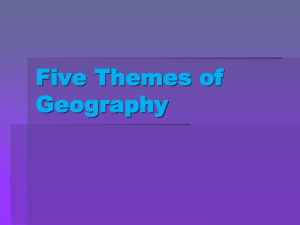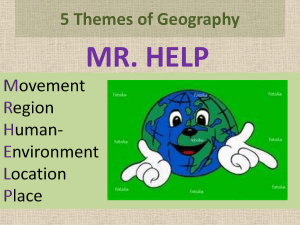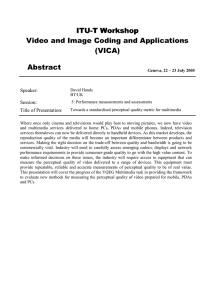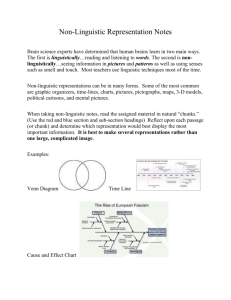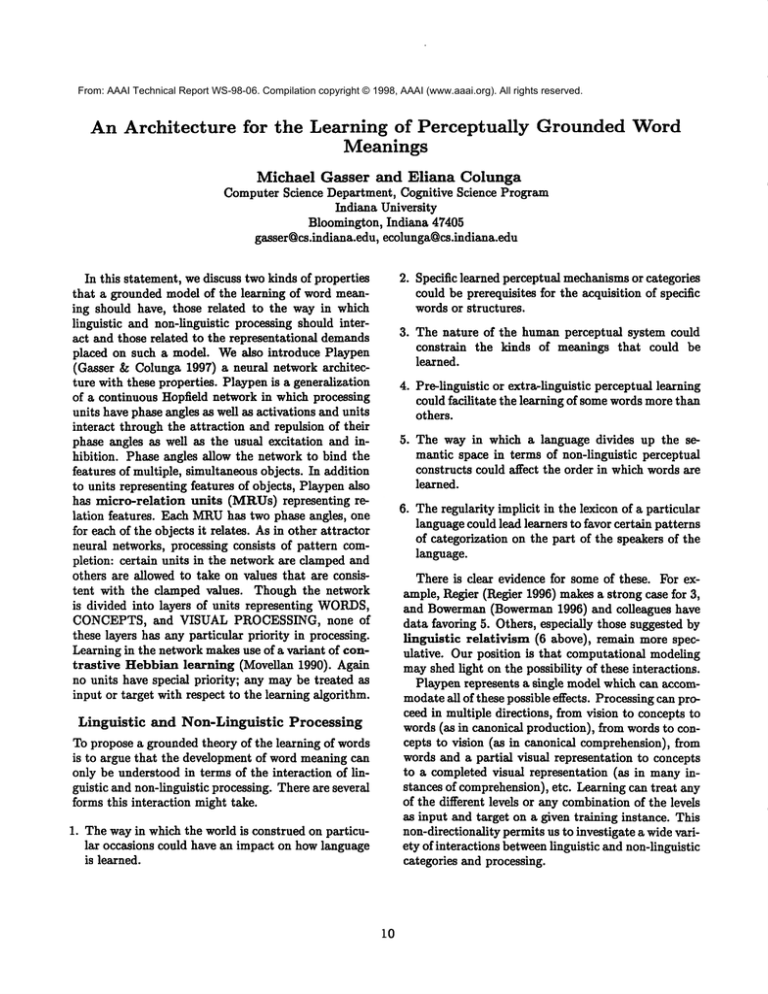
From: AAAI Technical Report WS-98-06. Compilation copyright © 1998, AAAI (www.aaai.org). All rights reserved.
An Architecture
for
the Learning of Perceptually
Meanings
Grounded Word
Michael Gasser and Eliana Colunga
Computer Science Department, Cognitive Science Program
Indiana University
Bloomington, Indiana 47405
gasser~cs.indiana.edu, ecolunga@cs.indiana.edu
In this statement, we discuss two kinds of properties
that a grounded model of the learning of word meaning should have, those related to the way in which
linguistic and non-linguistic processing should interact and those related to the representational demands
placed on such a model. Wealso introduce Playpen
(Gasser & Colunga 1997) a neural network architecture with these properties. Playpen is a generalization
of a continuous Hopfield network in which processing
units have phase angles as well as activations and units
interact through the attraction and repulsion of their
phase angles as well as the usual excitation and inhibition. Phase angles allow the network to bind the
features of multiple, simultaneous objects. In addition
to units representing features of objects, Playpen also
has micro-relation
units (MRUs) representing relation features. Each MRUhas two phase angles, one
for each of the objects it relates. As in other attractor
neural networks, processing consists of pattern completion: certain units in the network are clamped and
others are allowed to take on values that are consistent with the clamped values. Though the network
is divided into layers of units representing WORDS,
CONCEPTS, and VISUAL PROCESSING, none of
these layers has any particular priority in processing.
Learning in the network makes use of a variant of contrastive
Hebbian learning (MoveUan 1990). Again
no units have special priority; any may be treated as
input or target with respect to the learning algorithm.
Linguistic
and Non-Linguistic
Processing
To propose a grounded theory of the learning of words
is to argue that the development of word meaning can
only be understood in terms of the interaction of linguistic and non-lingnistic processing. There are several
forms this interaction might take.
1. The way in which the world is construed on particular occasions could have an impact on how language
is learned.
10
2. Specific learned perceptual mechanismsor categories
could be prerequisites for the acquisition of specific
words or structures.
3. The nature of the human perceptual system could
constrain the kinds of meanings that could be
learned.
4. Pre-lingnistic or extra-linguistic perceptual learning
could facilitate the learning of somewords more than
others.
5. The way in which a language divides up the semantic space in terms of non-linguistic perceptual
constructs could affect the order in which words are
learned.
6. The regularity implicit in the lexicon of a particular
language could lead learners to favor certain patterns
of categorization on the part of the speakers of the
language.
There is clear evidence for some of these. For example, Regier (Regier 1996) makes a strong case for
and Bowerman(Bowerman 1996) and colleagues have
data favoring 5. Others, especially those suggested by
linguistic relativism (6 above), remain more speculative. Our position is that computational modeling
mayshed light on the possibility of these interactions.
Playpen represents a single model which can accommodateall of these possible effects. Processing can proceed in multiple directions, from vision to concepts to
words (as in canonical production), from words to concepts to vision (as in canonical comprehension), from
words and a partial visual representation to concepts
to a completed visual representation (as in many instances of comprehension), etc. Learning can treat any
of the different levels or any combination of the levels
as input and target on a given training instance. This
non-directionality permits us to investigate a wide variety of interactions betweenlinguistic and non-linguistic
categories and processing.
Representational
and processes. It should allow for the variety of possible interactions between these two levels. Playpen imposes no direction on processing and learning, so it accommodates all such interactions.
A grounded model
should also build on an account of what form these perceptual categories take, how they take on that form,
and how they are associated with words. Playpen
solves these problems through the use of two kinds of
primitive units and a simple correlational learning algorithm.
Constraints
What are word meanings? A grounded perspective
on this question ties words to perceptual and motoric
categories, about which a lot is known.In particular,
research on categorization indicates that object categories are organized around rich patterns of correlations amongobject features (Rosch et al. 1976). Relational categories are more controversial, but work
by Billman and colleagues (Kersten & Billman 1997)
indicates that these differ more in degree than in kind
from object categories and are also defined in terms of
featural correlations.
Associating
a meaning with a word is in one
sense just a further correlation, one between perceptual/semantic features on the one end and lexical or
phonetic/phonological
features on the other. Like
the categories they refer to, words are either objects
(nouns) or relations (prepositions and verbs).
a noun together with its meaning represents a cluster
of object features, and a preposition together with its
meaningrepresents a cluster of relational features.
At the very least, then, representing and learning
word meanings requires the capacity to represent and
learn correlations betweenfeatures at different levels.
Manyneural network models permit this for features
of objects (COLOR,SIZE, etc.), but few have anything to day about the primitive perceptual features
of relations.
Playpen treats relations as composed
of binary micro-relations,
implemented as MRUs.In
Playpen the learning of relational correlations works
much the same way as the learning of object correlations, through a simple Hebbian form of learning.
At least two predictions follow from this approach
to relational knowledgeand learning.
References
Bowerman, M. 1996. Learning how to structure
space for language: A crosslinguistic perspective. In
Bloom, P.; Peterson, M. A.; Nadel, L.; and Garrett,
M. F., eds., Language and Space. Cambridge, MA:
MIT Press. 385-436.
Gasser, M., and Colunga, E. 1997. Playpen: Toward an architecture for modeling the development
of spatial cognition. Technical Report 195, Indiana
University, Cognitive Science Program, Bloomington,
IN.
Kersten, A. W., and Billman, D. 1997. Event category learning. Journal of Experimental Psychology:
Learning, Memoryand Cognition 23(3):658-???
Movellan, J. 1990. Contrastive Hebbian learning in
the continuous Hopfieid model. In Touretzky, D.; Elman, J.; Sejnowski, T.; and Hinton, G., eds., Proceedings of the Iggo Connectionist Models Summer
School San Mateo, CA: Morgan Kaufmann. 10-17.
Regier, T. 1996. The Human Semantic Potential: Spatial Language and Constrained Connectionism. Cambridge, MA:MIT Press.
Rosch, E. H.; Mervis, C. B.; Gray, W. D.; Johnson,
D. M.; and Boyes-Braem, P. 1976. Basic objects in
natural categories. Cognitive Psychology 8:382-439.
1. Each relation should start in a relatively contextspecific form, tied to particular pairs of objects or
particular kinds of objects. Later, as MRUsbecome
associated with one another, the relation becomes
more abstract. If this is true, we expect children to
have more context-specific relations than adults.
2. A major cause of the difference in ease of learning of
two relations should be the difference in the correlational structure behind the relations. For example,
left and right are more difficult than on and under
because while on benefits from all of the aspects of
the world which correlate with vertical orientation,
there is little more than horizontal orientation for
left.
In sum, a grounded model of the learning of word
meaningrelates linguistic and non-linguistic categories
11




